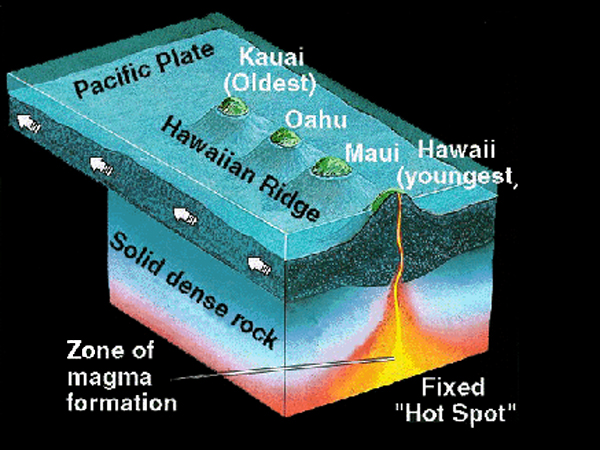
- In addition to forming new islands and volcanoes, hotspots may also help drive tectonic plates. Courtesy of: www.noaa.gov
After more than six years, I can still remember quite a few lessons from my earth science class in eighth grade. One of the more fascinating topics for me was plate tectonics, which explain the movement of the earth’s continents over its extensive geologic history. While I recall that the major force driving these plates is a convection of magma underneath the earth’s crust that pulls and pushes on the plates, yet another force has been found helping to drive these plates.
NatureThe most obvious example is the hotspot that formed the Hawaiian Islands and currently fueling Mauna Loa, Kilauea and Lo’ihi. While Lo’ihi is still forming underwater, Mauna Loa and Kilauea are still erupting on the Big Island, an incredible sight to see (not that I can speak for myself, as I have yet to visit the Big Island). In essence, these volcanoes are more than just awe-inspiring sights: they probably are literally making the earth move underneath your feet. Keep in mind that the hotspot itself has remained stationary and the magma plume has been flowing in the same direction; it is the Pacific Ocean crust that has been moving.
Another important and much more tell-tale hotspot has appeared just 70 million years ago, around the end of the dinosaurs. Among many other coupled events, scientists find that the appearance of this hotspot on the Indian subcontinent’s tectonic plate correlated with its movement north, colliding with Asia to form the Himalaya Mountains. This hotspot was responsible for the formation of volcanic rock deposits in regions such as the Deccan Traps containing flood basalt; since then the hotspot has moved down near Madagascar, most recently forming Reunion Island.
This finding helps explain some of mysteries in the geologic history of the Earth. Still, other questions remain about plate tectonics and hotspots themselves (just look up an image of the Hawaiian-Emperor seamount chain and see for yourself).
—Ian Yu, Science & Technology Editor




